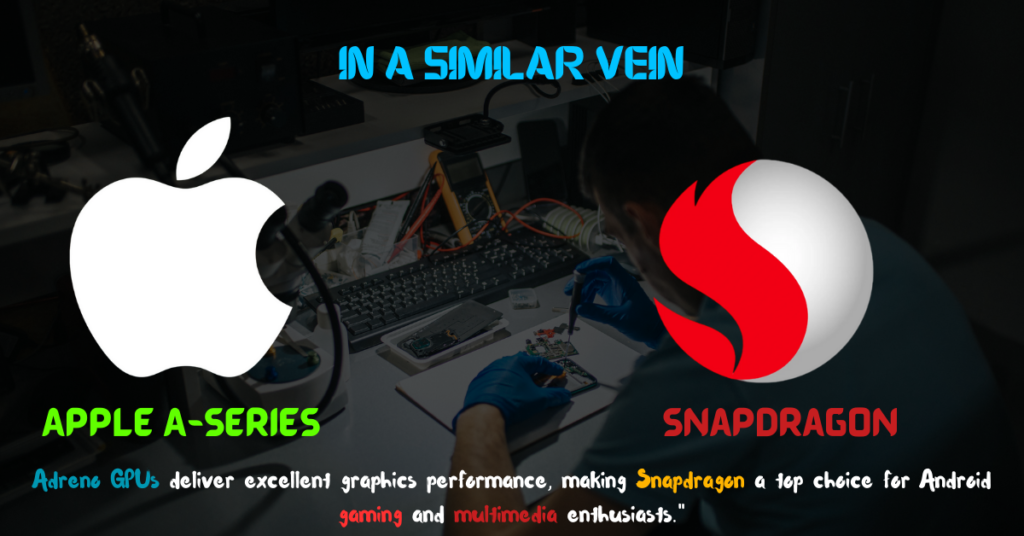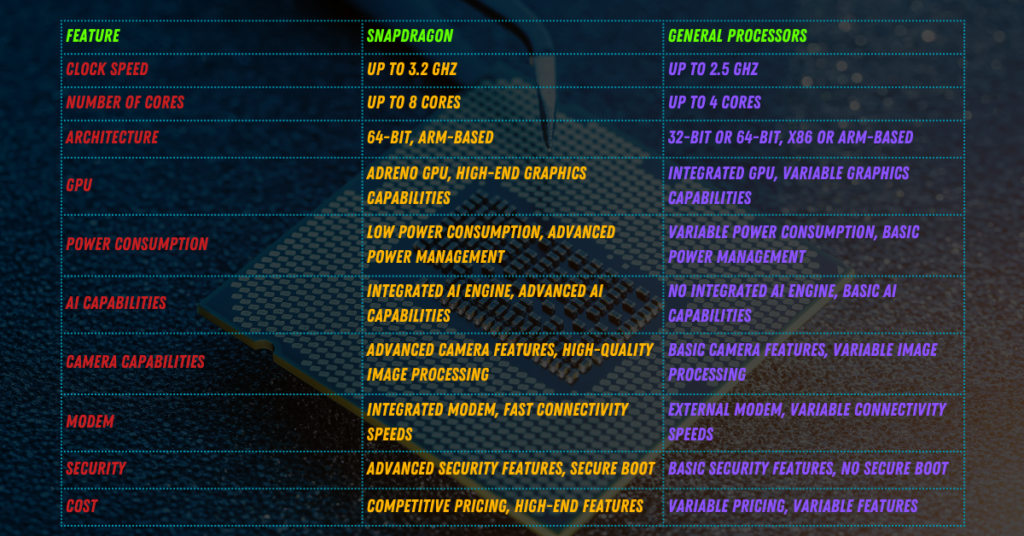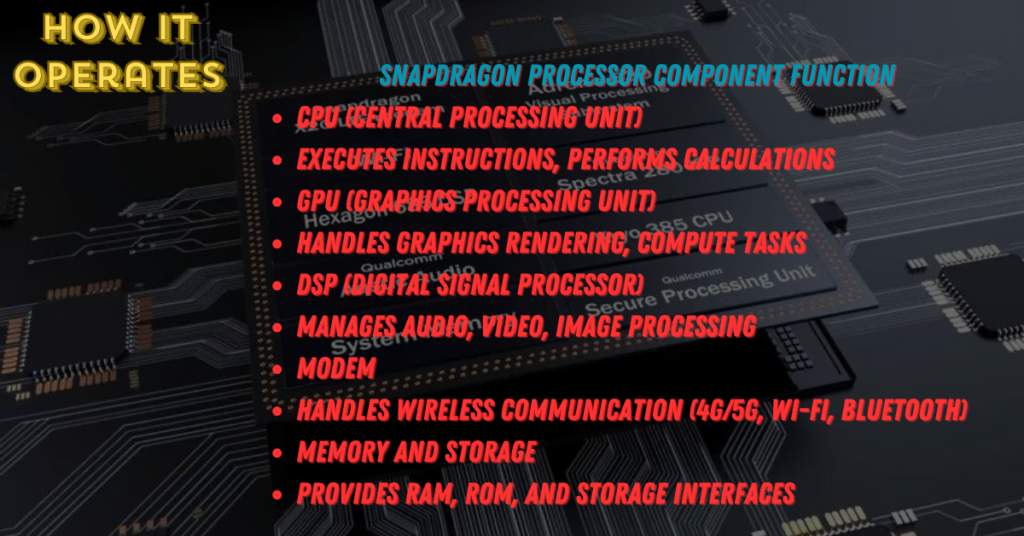It is the processor that forms the backbone of any mobile device in this fast-moving technological world of today, governing its speed, efficiency, and other major performance criteria. Out of several mobile processors available nowadays, Qualcomm’s Snapdragon series has made a significant market niche for itself and is perceived by people as a brand identified with high performance and innovativeness.
Table of Contents
ToggleThe reason behind Qualcomm Snapdragon Processor’s benefits and Snapdragon Processor their worldwide popularity is their balanced performance and strong efficiency; from medium-sized to premium high-end smartphones, you will find one working inside.

Qualcomm has always remained at the forefront in innovative mobile technologies and has broken boundaries by introducing a new generation in the series. The Snapdragon 8 Gen series, for example, is a powerful processing chipset Phone with advanced AI capabilities, strong support for 5G connectivity, among others. In a nutshell, these are what ideally made Snapdragon a strong competitor in the mobile processor markets.
On the other hand, Apple’s A-series processors have quite set a good benchmark in the industry, especially the new A16 Bionic chip. Known for their strong performance and flawless integration with iOS, Apple’s chips often outstrip their competitors purely on raw computing power and graphics performance.

This synergy of hardware and software design allows Apple to offer a user experience that no one can. Powered by its advanced neural engine and energy-efficient design, the A16 Bionic stands as representative technology for why Apple has been at the top of the performance charts.
Although it has been accused of not matching Snapdragon counterparts in performance within some markets, Samsung’s Exynos processors have some special advantages. For example, the Exynos 2200 is paired with a custom AMD RDNA 2-based GPU that touts far better graphics performance.
This partnership with AMD means that Samsung intends to beef up the gaming and multimedia capabilities on its devices. While Exynos chips might be a bit behind on performance from a mobile cpu comparison perspective, they really try to make up for lost ground by offering some innovative graphics solutions and integration in the Samsung ecosystem.
The MediaTek Dimensity series has been quite formidable in the compare mobile processor wars, especially at the mid-end spectrum. Beginning with the Dimensity 1200 and 9000 series, they were well-appaised for value for money and their performance—the drift of advanced AI processing and 5G support merged with impressive battery efficiency. Having used this very strategy of high-performance chips at competitive prices, MediaTek was the go-to choice for many manufacturers to drive 5G tech adoption into budget-friendly devices.
Comparing these processors, therefore, has to do with CPU mobile comparisons performance, GPU, AI integration, energy efficiency, and 5G connectivity. As such, Snapdragon processors are looked upon as all-rounders that provide balanced performance across nearly all features.
Apple’s A-series is championed by raw performance and seamless ecosystem integration, and then there are Samsung’s Exynos, hailed for their innovative graphics solutions. Finally, there’s MediaTek for the more cost-effective solutions without compromising on key features.
What is Snapdragon?
Snapdragon is a name of a System on a Chip semiconductor product designed and marketed by Qualcomm for mobile phones, netbooks, and various other handhelds. These processors come in with highly appreciable performance amongst energy efficiency.
The Snapdragon brand was launched by Qualcomm in 2007 and ever since has been through a number of product generations—each reigniting performance, graphics, and energy efficiency.
What are the Key Features of Snapdragon processor?

Advanced CPU Architecture
Advanced CPU architectures are applied in the Snapdragon processor, such as Kryo cores, which are highly efficient yet high-performance. This always comes with a mix between high-performance and energy-efficient cores, which scale in workload to ensure the battery life but guarantee fast performance when it matters for heavy applications.
Adreno GPU
The Adreno GPU incorporated into Snapdragon processors is an ultra-powerful method for rendering graphics. It delivers seamless, high-quality graphics rendering and is apt for gaming, video playback, and a host of multimedia applications. Adreno GPU enables advanced features like Vulkan, HDR Gaming, and High Refresh Rates.
5G Connectivity
Snapdragon processors are carriers of 5G innovations. Integrated 5G modems support both sub-6 GHz and mmWave frequencies, ensuring faster download and upload speeds, lower latency, and more reliable connections for a better mobile experience.
AI and Machine Learning
It features a dedicated AI engine for Snapdragon processors, accelerating machine learning. On-device AI comes in the form of voice recognition, image processing, and contextual awareness. The AI engine improves efficiency and performance in AI-powered applications.
Camera Enhancements
It comes with an Image Signal Processor that empowers advanced camera capabilities. High-resolution sensors and multi-camera setup are supported, with computational techniques such as HDR, low-light enhancement, and real-time object detection, ensuring better quality in photo and video capture.
Battery Efficiency
The Snapdragon processors are designed to use less power for every task they complete. Snapdragon processors are designed to be power-efficient, with advanced power management techniques that help prolong battery life. In addition, Qualcomm Quick Charge technology can charge devices faster, so they can spend less time plugged in and more time in use.
Security Features
Snapdragon processors are highly secure and have several complex security mechanisms at the hardware level, such as Qualcomm Secure Processing Unit; it enables secure key storage, biometric authentication support, and protection against malware and hacking attempts.
Audio Capabilities
The Snapdragon processors provide high-fidelity audio features by supporting technologies such as Qualcomm Aqstic audio, aptX, and aptX HD. These provide quality sound for music playback, voice calls, and audio recording to help enable a great auditory experience.
Networking and Connectivity
Besides 5G, Snapdragon processors support the latest Wi-Fi standards, wireless versions of Bluetooth 5.x, among others, that ensure high-speed and stable connections from streaming to gaming, IoT, and smart home devices.
Display Technology
Snapdragon processors support high refresh rate displays, 4K resolution, and HDR10+ playback for lively visuals and silky-smooth interaction, be it for gaming, video streaming, or even regular use.
Improved Thermal Management
The Snapdragon processors come with efficient thermal management solutions that implement advanced cooling technologies and thermal throttling mechanisms. This ensures optimal performance while maintaining a safe temperature, free from overheating, hence assuring reliable device performance at peak usage.
Integration with Qualcomm Technologies
Rapid fire Snapdragon processors are integrated with a variety of Qualcomm Technologies, including Qualcomm Hexagon DSP, which provides enhanced sensor processing, and Qualcomm Spectra ISP, enabling image processing that is truly second to none. These integrations pack an integrated, high-performance user experience into a myriad of applications.
How does Snapdragon Processors Work?

They have got complex architecture, including a CPU, GPU, and DSP with other components—all under one chip. The architecture is usually optimized for both performance and efficiency.
The major building blocks that compose Snapdragon processors are the Kryo CPU, Adreno GPU, Hexagon DSP, and Spectra ISP. Each of these components plays a critical role in achieving a balanced yet powerful performance.
Read More:- How to fix an error that occurred while installing IOS 17
How does Snapdragon compare to other mobile processors?
Snapdragon vs. Apple A-Series
When it comes to performance, both Snapdragon processors and Apple’s A-series chips are front-runners. Apple’s A-series chips used in iPhones have been very well-known for their high performance and efficiency.
In most cases, they set up neck-and-neck racing with the newest Snapdragon processors, which generally offer nearly identical functionality.
The chips from Snapdragon and Apple’s A-series are very power efficient. These, however, are offset by the fact that Apple’s custom designs probably give it a slight edge in terms of battery optimization and result in better power management for the same battery capacity in its devices.
Though Apple’s A-series chips are largely regarded as the best in terms of graphics, the Adreno GPUs still turn in an excellent performance graphically for Android devices from Snapdragon. This makes Snapdragon a strong choice for those who put great importance on gaming and multimedia experiences on Android.
AI Capabilities
Equipped with an AI engine right inside the chip, Snapdragon Processors excel in their AI capabilities. From enhancing cameras and voices to running several other AI-driven tasks—everything is done much more efficiently and effectively.
Meanwhile, Apple’s A-series chips are at par while performing AI tasks, optimizing the performance for smooth operation. However, in the case of Android devices, things become different.
The AI engine of Snapdragon is too much optimized that provides a far better experience with enhanced AI-driven features and performance. This makes Snapdragon a go-to for any individual seeking advanced AI capabilities in an Android device.
Snapdragon vs. MediaTek
The processor from MediaTek is cheap and gives good performance, which only makes it attractive for budget and mid-range phones. Coming to the flagship devices, though, Snapdragon processors seem to do a better job.
Their high-end CPUs and backing for advanced technologies make sure superior performance over the MediaTek processor in demanding applications and multitasking.
The strong point for Snapdragon will be its energy efficiency. In general, Snapdragon processors are known to use less power than those of MediaTek, hence allowing for longer battery life in smartphones.
This is important for all those users who spend their days using devices and don’t like recharging their batteries frequently.
Another area where Snapdragon excels is in terms of graphics performance. The Adreno GPUs of Snapdragon processors are generally ahead of the graphics solution that MediaTek offers, which delivers a smoother gaming experience along with visuals.
Whether graphically intensive gaming or high-definition videos, Snapdragon’s Adreno GPUs never fail to produce silky-smooth visuals.
Although MediaTek has been on a spectacular rise in terms of AI, Snapdragon still has a superior AI engine.
Snapdragon processors integrate jaw-dropping AI capabilities that give a device superb camera features, voice recognition abilities, and bring about increased efficiency in running the device. Thus, advanced integration such as this gives room for a better experience that is more intuitive.
Market availability and popularity Devices using Snapdragon Processors?
The list of the devices that are powered by Snapdragon processors is pretty long, it includes Samsung, OnePlus, Xiaomi, and many other devices. It is also used in many flagship as well as mid-range devices due to its versatile nature and improved performance.
Market Share:
Qualcomm Snapdragon processors allow mobile multitasking and provide users with efficient usage. Hence, Qualcomm is a market leader and has advertisements on market shares with its products of uniform performance and energy-saving features.
Benefits and Drawback of Snapdragon Processors!

List of positive view points of the Snapdragon Processors
- High-performance qualities
- Consumes less energy
- Provides great graphic display
- Strong AI functions
- Many leading brands used its superior technology, hence promoting the technology
List of drawback of using Snapdragon Processors
- It is an expensive purchase
- Sometimes models running remarkably have issues such as overheating
Snapdragon processors are quite dominant in the mobile processor market as they boast high performance, low power consumption, and some features. When it comes to being a powerful yet balanced performer across devices, while competitors like Apple’s A-series, MediaTek, Exynos, and Kirin in the market are strong alternative choices, Snapdragon still continues to be the best smartphone processor.
FAQs
What makes Snapdragon processors so special?
The high performance, power efficiency, and pretty good AI capabilities make Snapdragon processors quite a favorite among many smartphone brands.
Which brands use Snapdragon processors?
Brands like Samsung, OnePlus, Xiaomi, and many others use Snapdragon processors in their devices, ranging from flagship to mid-range models.
How do Snapdragon processors compare to Apple’s A-series chips?
While both offer excellent performance, Snapdragon processors are more commonly used in Android devices and offer a balanced performance with superior graphics and AI capabilities.
Are Snapdragon processors energy-efficient?
Yes, Snapdragon processors are designed with energy efficiency in mind, providing longer battery life for smartphones.
What can we expect from future Snapdragon processors?
Future Snapdragon processors are expected to feature even better performance, improved energy efficiency, enhanced AI capabilities, and advancements in 5G technology.





